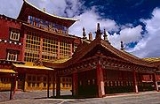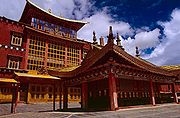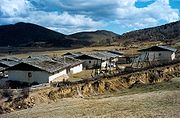
Shangri-La County
Encyclopedia
Shangri-La Countyis a primarily Tibetan
county in northwestern Yunnan
province, Southwest China
and is the location of the seat of the Dêqên Tibetan Autonomous Prefecture
.
in the 1933 James Hilton
novel Lost Horizon
, in an effort to promote tourism in the area. The local Tibetan population refers to it by the name Gyalthang , which is the Tibetan name for Jiantang Town (建塘镇 Jiàntáng Zhèn), the county seat.
(Köppen
Dwb), with influences from the monsoon
and the high elevation. Winters are chilly but sunny, with nighttime lows often dropping below −15 °C, while summers are cool, with daytime highs of around 19 °C (66.2 °F), and feature frequent rain; more than 70% of the annual precipitation is delivered from June to September. Except during the summer, nights are usually sharply cooler than the days. Despite the dryness of the winter, the small amount of precipitation is generally sufficient to cause major transportation dislocations and isolate the area between November and March.


Tibetan people
The Tibetan people are an ethnic group that is native to Tibet, which is mostly in the People's Republic of China. They number 5.4 million and are the 10th largest ethnic group in the country. Significant Tibetan minorities also live in India, Nepal, and Bhutan...
county in northwestern Yunnan
Yunnan
Yunnan is a province of the People's Republic of China, located in the far southwest of the country spanning approximately and with a population of 45.7 million . The capital of the province is Kunming. The province borders Burma, Laos, and Vietnam.Yunnan is situated in a mountainous area, with...
province, Southwest China
Southwest China
Southwest China is a region of the People's Republic of China defined by governmental bureaus that includes the municipality of Chongqing, the provinces of Sichuan, Yunnan and Guizhou, and the Tibet Autonomous Region.-Provinces:-Municipalities:...
and is the location of the seat of the Dêqên Tibetan Autonomous Prefecture
Dêqên Tibetan Autonomous Prefecture
Diqing Tibetan Autonomous Prefecture is an autonomous prefecture in Yunnan. It has an area of 23,870 km² and has its capital at Shangri-La County.- Subdivisions :Diqing is divided into three counties, among which one is an autonomous county.-Air:...
.
Name
The county was formerly called Zhongdian County (Chinese: 中甸县 Zhōngdiàn Xiàn) but was renamed in 2001 after the fictional land of Shangri-LaShangri-La
Shangri-La is a fictional place described in the 1933 novel Lost Horizon by British author James Hilton. Hilton describes Shangri-La as a mystical, harmonious valley, gently guided from a lamasery, enclosed in the western end of the Kunlun Mountains...
in the 1933 James Hilton
James Hilton
James Hilton was an English novelist who wrote several best-sellers, including Lost Horizon and Goodbye, Mr. Chips.-Biography:...
novel Lost Horizon
Lost Horizon (novel)
Lost Horizon is a 1933 novel by English writer James Hilton. It is best remembered as the origin of Shangri-La, a fictional utopian lamasery high in the mountains of Tibet.-Overview:...
, in an effort to promote tourism in the area. The local Tibetan population refers to it by the name Gyalthang , which is the Tibetan name for Jiantang Town (建塘镇 Jiàntáng Zhèn), the county seat.
Towns
- Jiantang Town
- Zhongdian Town
- Hutiaoxia TownHutiaoxia TownHutiaoxia Town , formerly Qiaotou , is a small town located on the Yangtze River in Shangri-La County adjacent to Lijiang City, Yunnan Province, China. Hutiaoxia is the south end of the famous Tiger Leaping Gorge hiking route, the other end of which is Daju in Lijiang...
- Jinjiang Town
- Luoji Township
Climate
Shangri-La has a humid continental climateHumid continental climate
A humid continental climate is a climatic region typified by large seasonal temperature differences, with warm to hot summers and cold winters....
(Köppen
Köppen climate classification
The Köppen climate classification is one of the most widely used climate classification systems. It was first published by Crimea German climatologist Wladimir Köppen in 1884, with several later modifications by Köppen himself, notably in 1918 and 1936...
Dwb), with influences from the monsoon
Monsoon
Monsoon is traditionally defined as a seasonal reversing wind accompanied by corresponding changes in precipitation, but is now used to describe seasonal changes in atmospheric circulation and precipitation associated with the asymmetric heating of land and sea...
and the high elevation. Winters are chilly but sunny, with nighttime lows often dropping below −15 °C, while summers are cool, with daytime highs of around 19 °C (66.2 °F), and feature frequent rain; more than 70% of the annual precipitation is delivered from June to September. Except during the summer, nights are usually sharply cooler than the days. Despite the dryness of the winter, the small amount of precipitation is generally sufficient to cause major transportation dislocations and isolate the area between November and March.
National park


- Pudacuo National ParkPudacuo National ParkPudacuo National Park is a national park located in Shangri-La County, Yunnan Province in the People's Republic of China. The park was announced on June 25, 2007, and is notable as the first national park in China to meet International Union for Conservation of Nature standards. It incorporates...
, the first national park in China to meet IUCN standards, also incorporates the Three Parallel Rivers of Yunnan Protected Areas World Heritage Site.
Transport
- The town's airport is Diqing AirportDiqing AirportDêqên Shangri-La Airport is an airport in the Dêqên Tibetan Autonomous Prefecture, Yunnan Province, China .-Airlines and destinations:...
. Covering an area of 225 hectares, it is one of the biggest airports in the northwest of Yunnan Province. There are flights to KunmingKunming' is the capital and largest city of Yunnan Province in Southwest China. It was known as Yunnan-Fou until the 1920s. A prefecture-level city, it is the political, economic, communications and cultural centre of Yunnan, and is the seat of the provincial government...
, ChengduChengduChengdu , formerly transliterated Chengtu, is the capital of Sichuan province in Southwest China. It holds sub-provincial administrative status...
, LhasaLhasaLhasa is the administrative capital of the Tibet Autonomous Region in the People's Republic of China and the second most populous city on the Tibetan Plateau, after Xining. At an altitude of , Lhasa is one of the highest cities in the world...
, GuangzhouGuangzhouGuangzhou , known historically as Canton or Kwangchow, is the capital and largest city of the Guangdong province in the People's Republic of China. Located in southern China on the Pearl River, about north-northwest of Hong Kong, Guangzhou is a key national transportation hub and trading port...
and ShenzhenShenzhenShenzhen is a major city in the south of Southern China's Guangdong Province, situated immediately north of Hong Kong. The area became China's first—and one of the most successful—Special Economic Zones...
. - Many travelers use the county town as a gateway into TibetTibetTibet is a plateau region in Asia, north-east of the Himalayas. It is the traditional homeland of the Tibetan people as well as some other ethnic groups such as Monpas, Qiang, and Lhobas, and is now also inhabited by considerable numbers of Han and Hui people...
, either travelling many days overland by jeep to LhasaLhasaLhasa is the administrative capital of the Tibet Autonomous Region in the People's Republic of China and the second most populous city on the Tibetan Plateau, after Xining. At an altitude of , Lhasa is one of the highest cities in the world...
, or by flying from the city's airport. However, the town itself is a tourist destination, primarily due to the nearby Gandan Sumtseling MonasteryGandan Sumtseling MonasteryThe Monastery built in the 17th century as the largest Buddhist monastery in Yunnan province, after a revelation by the Fifth Dalai Lama is in accordance with Tibetan traditional architectural style. It has six main structures including eight colleges...
(Chinese: 松赞林寺 Sōngzànlín Sì), Pudacuo National ParkPudacuo National ParkPudacuo National Park is a national park located in Shangri-La County, Yunnan Province in the People's Republic of China. The park was announced on June 25, 2007, and is notable as the first national park in China to meet International Union for Conservation of Nature standards. It incorporates...
, and Tiger Leaping GorgeTiger Leaping GorgeTiger Leaping Gorge is a canyon on the Yangtze River – locally called the Golden Sands River – located 60 km north of Lijiang City, Yunnan in southwestern China...
. - China National Highway 214China National Highway 214China National Highway 214 runs from Xining, Qinghai to Jinghong, Yunnan. It is 3,256 kilometres in length and runs south from Xining towards Tibet, and ends in Yunnan Province.-Route and distance:-External links:*...
See also
- Shangri-LaShangri-LaShangri-La is a fictional place described in the 1933 novel Lost Horizon by British author James Hilton. Hilton describes Shangri-La as a mystical, harmonious valley, gently guided from a lamasery, enclosed in the western end of the Kunlun Mountains...
- Three Parallel Rivers of Yunnan Protected AreasThree Parallel Rivers of Yunnan Protected AreasThe Three Parallel Rivers of Yunnan Protected Areas is a UNESCO World Heritage Site in Yunnan province, China.It lies within the drainage basins of the upper reaches of the Yangtze , Mekong and Salween rivers, in the Yunnanese section of the Hengduan Mountains.-Overview:-Geography:The protected...
- UNESCO World Heritage Site
External links
- Shangri-La County Official Website
- Shangrila from Wikitravel

